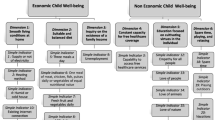Abstract
This is the first effort to construct a multidimensional index of child well-being in Iran. This index is composed of 26 indicators which cover the following aspects of child well-being: health, material well-being, education, risk and safety, family, personal well-being, and housing and the environment. Indicators were aggregated in special components, and these components eventually construct a single well-being index. The macro data was retrieved from national data centers to compute the province-level child well-being index for Iran. Results show that child well-being and its domains are distributed unequally among the provinces. Southern and eastern provinces have the worst condition while northern and central provinces have the best. Generally, Iranian children have made significant progress in recent years in education (such as literacy rate and high school graduation rate) and health (such as infant mortality rate and underweight children under 5 years of age). However, there are growing problems in the country, including child labor, high levels of exclusion from high school, a shortage of preschool education, and child abuse.
Similar content being viewed by others
References
Ben-Arieh, A. (2006). Measuring and monitoring the well-being of young children around the world. Background paper prepared for the Education for All Global Monitoring Report 2007. Strong foundations: Early childhood care and education.
Ben-Arieh, A. (2008). The child indicators movement: Past, present and future. Child Indicators Research, 1, 3–16.
Ben-Arieh, A., & Frønes, I. (2011). Taxonomy for child well-being indicators: A framework for the analysis of the well-being of children. Childhood, 18, 460–476.
Bradshaw, J., & Richardson, D. (2009). An index of child well-being in Europe. Child Indicators Research, 2(3), 319–351.
Bradshaw, J., Hoelscher, P., & Richardson, D. (2007). An index of child well-being in the European Union. Social Indicators Research, 80, 133–177.
Cerny, C. A., & Kaiser, H. F. (1977). A study of a measure of sampling adequacy for factor-analytic correlation matrices. Multivariate Behavioral Research, 12(1), 43–47.
Hagerty, M. R., & Land, K. C. (2007). Constructing Summary Indices of Quality of Life: A Model for the Effect of Heterogeneous Importance Weights. Sociological Methods and Research, 35(May), 455–496.
Hanafin, S., Brooks, A. M., Carroll, E., Fitzgerald, E., Nic Gabhainn, S., & Sixsmith, J. (2007). Achieving consensus in developing a national set of child well-being indicators. Social Indicators Research, 80(1), 79–104.
Heshmati, A., Bajalan, C., & Tausch, A. (2007). Measurement and analysis of child well-being in middle and high income countries. IZA Document Paper, No. 3203.
Land, K. (2007). Trends in infancy/early childhood and middle childhood well-being, 1994–2006: A composite index of trends in the well-being of America’s children and youth. North Carolina: Duke University Press.
Land, K. C., et al. (2001). Child and youth well-being in the United States, 1975–1998: Some findings from a new index. Social Indicators Research, 56(3), 241–318.
Mohaqeqi Kamal, S. H., Rafiey, H., Sajjadi, H., Rahgozar, M., & Abbasian, E. (2015). Territorial analysis of social welfare in Iran. Journal of International and Comparative Social Policy, 31(3), 271–282.
Nardo, M., Saisana, M., Saltelli, A., Tarantola, S., Hoffman, A., & Giovannini, E. (2008). Handbook on constructing composite indicators: Methodology and user guide. OECD Statistics Working Paper, STD/DOC(2008)3. Resource document. Retrieved from http://www.olis.oecd.org/olis/2005doc.nsf/.
National Organization for Civil Registration. (2012). Iran Statistical Yearbook. Tehran: National Organization for Civil Registration of Iran.
O’Hare, W. P., Mather, M., Dupuis, G., Land, K. C., Fu, Q., & Lamb, V. L. (2013). Analyzing differences in child well-being among U.S. States. Child Indicators Research, 6(2), 401–431.
OECD. (2009). Doing better for childern. Paris: OECD Publishing.
Statistical Center of Iran. (2011). Iran Statistical Yearbook. Tehran: Statistical Center of Iran.
UNICEF. (2007). Child poverty in perspective: An overview of child well-being in rich countries, Innocenti Report Card (Vol. 7). Florence: UNICEF Innocenti Research Centre http://www.unicef-irc.org/publications/pdf/rc7_eng.pdf.
UNICEF. (2012). The Country Programme Action Plan between the Government of the Islamic Republic of Iran and the UNICEF (2012–2016). Retrieved from https://www.unicef.org/iran/children.html.
Vameghi, M., Sajjadi, H., Rafiey, H., & Rashidian, A. (2012). The socioeconomic status of street children in Iran: A systematic review on studies over a recent decade. Children and Society. https://doi.org/10.1111/j.1099-0860.2012.00456.x.
Acknowledgements
This study was supported by a research grant from the Social Welfare Research Center, Deputy of Research and Technology, University of Social Welfare and Rehabilitation, Tehran, Iran.
Author information
Authors and Affiliations
Corresponding author
Rights and permissions
About this article
Cite this article
Vameghi, M., Mohaqeqi Kamal, S.H., Sajjadi, H. et al. A Territorial Analysis of Child Well-Being in Iran: Introducing a Multidimensional Index. Child Ind Res 11, 1465–1475 (2018). https://doi.org/10.1007/s12187-017-9493-4
Accepted:
Published:
Issue Date:
DOI: https://doi.org/10.1007/s12187-017-9493-4




